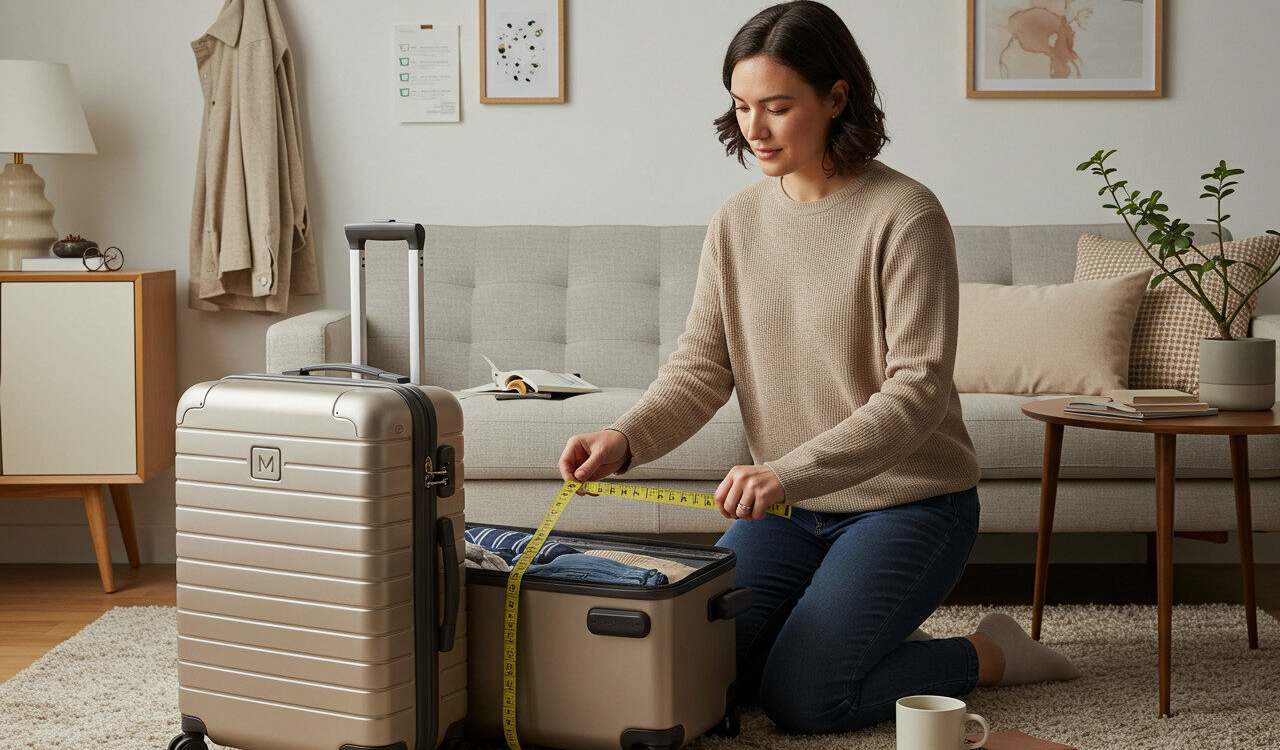How Do I Measure Luggage? Tips for Accurate Sizing
- Measure your luggage’s height, width, and depth, including wheels and handles, to calculate total linear inches.
- Most airlines have specific size and weight limits for carry-on and checked luggage.
- Use a measuring tape and weigh your luggage on a scale to avoid baggage fees.
- Always check your airline’s website before flying, as size requirements may vary.
- Understanding linear inches and expandable sections helps ensure compliance.
Introduction
Knowing how to measure your luggage correctly is essential for a smooth airport experience. With strict baggage size and weight limits enforced by most airlines, inaccurate measurements could lead to unexpected fees or delays at check-in. By understanding how to measure your suitcase, including handles and wheels, you can ensure it fits within the dimensions set for overhead bins or checked luggage. This guide outlines the tools, techniques, and terms you need to measure your luggage accurately.
Luggage Size Requirements in the U.S.
What Do Airlines Consider as Luggage Size?
Airlines in the U.S. measure luggage size using a method known as “linear inches,” the sum of your bag’s height, width, and depth. For example, if your suitcase measures 24 inches high, 16 inches wide, and 14 inches deep, the total is 54 linear inches.
Each airline may have slight variations in their size policies, but the general standards are
| Luggage Type | Common Size Limit | Weight Limit |
|---|---|---|
| Carry-On | 22 x 14 x 9 inches (LWH) | 15–20 lbs (7–9 kg) |
| Checked Bag | 62 linear inches total | 50 lbs (23 kg) |
Before packing, visit your airline’s website to review their exact luggage policies, especially for international travel or budget carriers that may enforce stricter rules.
Why Accurate Measurement Matters
Incorrect luggage measurements can lead to oversized baggage fees or delays at the airport. Inaccurate dimensions, especially if wheels and handles are not included, may result in your bag exceeding the allowed limits.
Proper measurement ensures:
- No surprise fees at check-in.
- Smooth boarding and stowing in overhead bins.
- Better packing decisions when staying within airline size rules.
Dimensions, Linear Inches, and Volume
Dimensions
Refers to your luggage’s height, width, and depth, including all protrusions like wheels, handles, and side pockets.
Linear Inches
Linear inches are calculated by adding:
Height + Width + Depth = Linear Inches
This measurement is the industry standard for luggage size compliance.
Volume
Volume measures interior capacity (often listed in liters). While useful for packing, airlines rarely use this for luggage restrictions.
External vs. Internal Measurements
- External measurements include wheels, handles, and exterior compartments crucial for airline compliance.
- Internal measurements refer to the usable packing space inside the bag.
Tip: Manufacturer labels often list internal dimensions, which can be misleading for travel purposes. Always measure the full external size yourself.
What You Need to Measure Your Luggage
Essential Tools
To measure luggage accurately, you’ll need:
- Measuring tape (flexible, with inches or centimeters)
- Flat surface to keep the bag upright and stable
- Pen and paper or phone app to record dimensions
- Luggage scale to weigh your packed bag
Common Mistakes to Avoid When Measuring
Avoid these frequent errors:
- Not including wheels or handles in your measurement
- Relying solely on manufacturer size listings
- Forgetting to measure expanded compartments
- Measuring an empty or compressed bag rather than when fully packed
These missteps can lead to oversized classification and added charges.
Guide to Measuring Luggage Correctly
Step 1: Measure Height, Width, and Depth
Use a measuring tape to record:
| Dimension | What to Measure |
|---|---|
| Height | From the floor (bottom of wheels) to the top of the handle |
| Width | Across the front of the suitcase, including side handles |
| Depth | From front to back, including exterior pockets or bulges |
Ensure the bag is upright and fully packed when measuring.
Step 2: Calculate Linear Inches and Account for Expansion
Add height + width + depth to calculate total linear inches.
Example: 24” (H) + 14” (W) + 13” (D) = 51 linear inches
If your suitcase has expandable sections, measure it both zipped and unzipped. Some airlines measure luggage in its fully expanded state.
Conclusion
Measuring your luggage correctly is a smart way to avoid travel headaches and added fees. Use the right tools, understand airline requirements, and measure every part of your bag, including wheels and handles. By doing so, you can confidently pack for your trip and breeze through airport check-ins.
Need personalized travel tips or packing advice? Reach out for a free consultation. Safe travels!
Updated by Albert Fang
Source Citation References:
+ Inspo
There are no additional citations or references to note for this article at this time.
